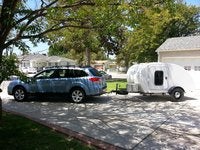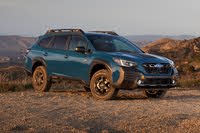3.6 vs. 2.5 - Reliability, Stalling and Oil Burning
Asked by Mark Dec 27, 2016 at 12:42 PM about the 2010 Subaru Outback 2.5i Limited
Question type: General
Recently, I've read and heard from several sources that there's more STALLING
problems with the 3.6 H6 Boxer engines. This is NOT GOOD.
In traffic situations, it's very dangerous to have your engine stall especially
when making left turns in front of oncoming cars. So, what's your take and
experience on this. Have you had better performance and drivability from the
H4 2.5 engine? There's certainly MORE of them in circulation.
20 Answers
The 2.5 engines are tried and true and have a pretty good reputation up to the year of your car except for the head gasket issue. After that they tend to use oil. As far as reliability I have not heard of any difference between the 6's and the 4's but the smaller engines will get significantly better gas mileage. . The later 6 cylinder engines also have oil burning issues.
Full_of_Regrets-. OK, thanks. The 2.5 Four seems to make up 80 percent of all the cars and the redesigned head gaskets starting in 2010 are very helpful. I wasn't aware of the 3.6 H6 oil burning issues, which years are you referring to? The oil burning FOUR cylinder is the subject of the lawsuit with the Outback in 2013, 2014 , BUT, no mention of the 3.6 .
I'm hearing more about the STALLING of the 3.6 engine.. this would make me very upset if I had this problem!
Mark - if you check around you will find the 6's also use oil as they have the same design, just two more cylinders. http://www.cheatsheet.com/automobiles/30-new-cars-that-burn-way- too-much-oil.html/?a=viewall
Full_of_Regrets - thanks, but, what is with this STALLING issue?
I don't have any evidence about stalling and the original poster did not present any either.
VolvoSubieTech answered 7 years ago
I know the 2010-11 earlier production H4's had a torque converter issue that would cause them to stall out when coming to a stop. There was a torque converter redesign after that that cured the problem. Never heard of that issue with the 3.6L though, different transmission entirely.
VolvoSubieTech- OK, that's a CVT thing... I've heard a lot of 2013s have also had this problem.. So, are you saying that you can just replace the torque converter, if this happens? Also, what mileage range have you noticed that this becomes a problem?
VolvoSubieTech answered 7 years ago
Markw - I know specifically that the bulletin/updated part only applied to 2010-2011, it was a change in the bearing design inside the torque converter, and I assume going forward, Subaru continued to use the updated design....so I wouldn't just throw a torque converter in it and hope it works, no. The few that I replaced were between 60k and 120k, if memory serves correctly. I'm pretty certain the 3.6 didn't get the CVT until 2015 model year, and the dealership I worked for never ran into any significant stalling problems with the 5EAT that came in any H6 equipped Subie. Sounds like something possibly fuel quality/fuel pressure related honestly, most likely not transmission related.
VolvoSubieTech- OK, you have covered a couple of issues here. Are you saying that the "updated part" was applied to the 2010 and 2011 bearing or that the later models had a newer improved bearing?? You're correct, the CVT transmission was not on the 3.6 H6 until 2015. Now many CVTs did you replace on average between 60,000 and 120,000 miles?? Really depends on how you drive your car, I suppose.. a lot of people abuse their cars... I know someone who went 300,000 miles on his 2010 CVT transmission and had the fluid change periodically. Yes, 120,000 miles is fine, 60,000 not so much. I have 82,000 miles on my 2010 Subaru Outback Limited and it drives fine.
VolvoSubieTech answered 7 years ago
The updated part that we ordered and installed to correct the stalling out when coming to a stop issue was basically the production part that was used on later models, so all the same generation CVTs that have been made since at least 2013 have the new needle bearing-style thrust washer torque converter. The previous thrust washer was a solid bushing type. I know there are a ton of 2010-2012 Outbacks with the CVT out there that will probably never have an issue, just the ones that did, it was obvious. When the CVT first came out, we were replacing TONS of them due to just being loud, all under warranty, so it had to have been under 60k miles. I think I remember hearing we had done the most in the Northeast region in the early stages of 2010-2011 when they had just started coming out.
VolvoSubieTech- thank you very much for this expository answer and clarification. I have the 2010 Subaru Outback and had a complete fluid change at the Subaru dealership; it wasn't cheap, but, I thought it's good insurance since I do occasionally tow a small 1,000 pound teardrop trailer. Here's a picture of the rig. I'm very careful not to do fast jack rabbit starts with my car. I friend who is in the automotive business told me that it's especially hard on the transmission for any car. As far as noise goes, there's a certain sound to the CVT transmission as it spools up, but, I think that's normal. I have heard from others about the stalling issue with the CVTs and I'm not having any problems with this, thank goodness. As I have almost 82,000 miles on my car, I'm wondering if I'm in OK shape or need to be concerned about the CVT. Only a couple of times have I noticed that there's a little vibration when backing up. Curious?? The person I know who travelled almost 300,000 miles did a lot of highway driving and this car is primarily my road car with the trailer. I do occasionally drive it in LA traffic, but, I try to use it more for longer distance trips on the freeway. The car is super comfortable and just cruises nicely. I only open up the throttle after I'm rolling about 20 to 25 mph. It takes off and is VERY responsive. Has absolutely no problem getting up to speed. What I do know about the 1st generation CVT is that the unit is physically larger than the 2013 2nd generation and that the high torque 2015 model used for the 3.6 engine is the same size as the 1st generation unit. At least once, I've read an opinion that the 1st generation was "overbuilt" and that they made the 2nd generation a lighter weight unit to save fuel. I'm thinking that any mileage above 120,000 miles on the original transmission is about normal. But, I would hate to have to replace the entire unit prematurely, it's very expensive. Would very much appreciate your thoughts.
VolvoSubieTech- see this discussion from a 2013 Subaru Outback CVT owner, https://www.cargurus.com/Cars/Discussion-t44088_ds763571
VolvoSubieTech answered 7 years ago
Not knowing service history is a hell of a thing too. We had more than one case of a independent or chain oil change place start draining a CVT, cap it off and not bother to tell the customer, which later caused issues. Sounds about like what happened to that person. Your friend is a wise person. Subaru's in particular seem to just have bad, bad luck when towing anything, doesn't seem to matter how much of a load it is. I suspect your vibration is definitely drivetrain related, but pinpointing exactly what would be tough, especially if it only does it with the trailer attached. Our recommendation to customers was a CVT fluid change at 100k, though any significant, regular towing would definitely shrink that interval.
kemposensei answered 6 years ago
You guys are freaking me out. Today I am picking up a 2013 3.6 Outback that I traded my beloved Rubicon for. Stalling, oil and reliability, oh my! This car has 54K on it. Hope I didn't make a mistake. Time will tell I guess.
Buy a Subaru backed extended warranty!!!
We have a 2016 3.6 Legacy sedan with no issues. We prefer it over our 2010 2.5 and the 2016 2.5 we had previously. We have 38,000 miles with no oil burning issues. The only fail we had was a bad battery cell at 28,000 miles. Dealership replaced with a higher cca battery as they felt oem battieres were under powered.
Sounds like it isnt actually an issue to me. A few cars out of millions ? Percentage wise not even enough to make a new car buyer reconsider buying a Subaru , when there are so many other worse brands out there...
Vaughn_Lee answered 5 years ago
2018 OB with 15k. Stalling issues at turns, more left then right and hesitation while driving @ freeway speeds. Valve issues is the problem along with a few other's that just don't mesh up with the fuel propulsion system and the software for the cvt to rpm aka throttle input. It's been looked at three times my wife taking it there got the run around and a false service. I show up demand ride along with tech while it's hooked up to computer...oh? gee, now it's showing the NOHC dropping way below..? Why no engine light? Was then told that Subaru knows, they don't wanna rewrite the software so they have to manually reset the valves and that should fix it...NOPE. Stay far away from these. Buy Toyota!
I had a 2012 outback with 155,000. I had the timing belt and the head gasket and the transmission fluid all done at 100,000 service and the car ran great up until the catalytic converter went bad and I couldn't get it inspected because the check engine light never went off. Tires, brakes and oil and that's really all my subie needed to keep running strong. I have a p.o.s. rogue and the CVT trashmission blew up at 65000 miles!

